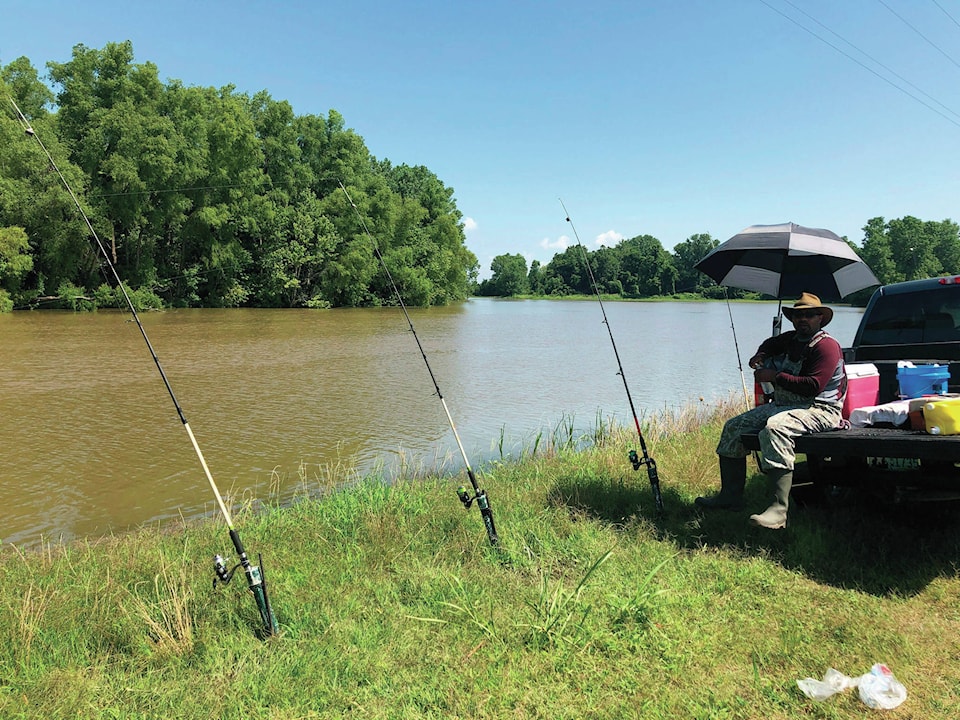RIPLEY, Tenn. — Wearing wading boots and a wide-brimmed hat, Derrick Currie casts his green fishing line into a pool of brown water along a rural Tennessee road.
In a couple of minutes, he reels in his flapping bounty: A nice-sized catfish that he puts in a cooler to take home.
Currie’s fishing hole looks like a lake, but it isn’t one. It’s farmland inundated by floodwater.
Lush green fields of cotton and soybeans turned into lakes Tuesday as flooding from the overfull Mississippi River covered thousands of acres of farmland in Lauderdale County in west Tennessee.
Officials say about 175,000 acres of farmland are now underwater in the worst time of year. County Mayor Maurice Gaines Jr. says early July flooding means farmers won’t be able to replant in time for the fall harvest, ruining countless numbers of crops.
The Mississippi River was cresting at 35 feet (10.7 metres) Tuesday near Ripley. Flood stage is 28 feet (8.5 metres), according to the National Weather Service.
“It’s been devastating,” Gaines said Tuesday. “These waters couldn’t have come at a more inopportune time. Most of the farmers have all their fields planted.”
In February, flooding along the Mississippi, Tennessee and other rivers in the South caused billions of dollars in damage to homes, businesses and farmland. In late June, Tennessee Gov. Bill Lee announced that U.S. Small Business Administration disaster loans were available to residents and businesses affected by the February flooding in 19 counties.
Heavy rains caused catastrophic flooding along the Arkansas River in Oklahoma and Arkansas this spring. Trouble is now being seen farther south along the Mississippi River.
Lauderdale and surrounding low-lying counties are used to flooding from the Mississippi and its tributaries, but not this bad. Farmers built makeshift levees to keep the water away, but many have failed, sending rising water into their properties, Gaines said.
No evacuations have been ordered, but some houses that sit on slightly elevated land are surrounded by water. Egrets and other wading birds seem right at home, standing still as statues on what recently was dry land as they hunt for fish. Parts of the county look more like Florida’s Everglades than Tennessee’s Mississippi River valley.
Some roads are closed. On Highway 19, brown river water turns to white rapids as it flows over rocks on the side of the road.
Not far away, Currie deploys five fishing lines into the flooded farmland, and then waits for a bite. He’s seen gar, drum and bluegill, but he’s aiming for tasty catfish.
Currie says he feels sorry for the farmers, but he jumps at the chance to fish the flooded land. Still, he does not recall flood waters being this high for this long - since February, he says.
“You can’t get to the river, so you have to fish the backwaters,” said Currie, 52.
On Tuesday, U.S. Rep. David Kustoff toured flooded areas of the county, located north of Memphis. Kustoff said he would try to get federal assistance for affected farmers, who already deal with high insurance costs.
“It would be one thing if this flooding took effect earlier in the year, where they could still plan,” Kustoff said. “But now we’re in July. It’s very tough to make the rest of the year salvageable.”
Despite the damage to cotton and soybeans, there’s reason to celebrate in Ripley, which is best known for its plump, sweet tomatoes. Gaines says the annual tomato festival planned for mid-July won’t be affected by the flooding.
